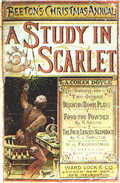Comics /
Cult Favorite
The Original Caped Crusader
By Philip Schweier
March 13, 2007 - 06:54
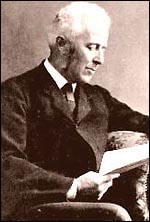 |
| Dr. Joseph Bell, the inspiration behind Sherlock Holmes |
Batman has claimed many literary ancestors, but perhaps the best known is master detective Sherlock Holmes.
Holmes was created by Sir Arthur Conan Doyle, who, as a young medical student, encountered teacher/physician Dr. Joseph Bell (1837-1911) at the University of Edinburgh. Bell had a reputation for being able to discern an extraordinary number of details of a person’s life merely through observation and deduction. A seemingly cursory examination could reveal facts about a person’s profession, family circumstances, and general health.
Doyle used his former instructor as a template in creating Holmes, who made is debut in the November 1887 issue of
Beeton’s Christmas Annual. Over the next 40 years, Doyle would go on to pen 53 short stories and four novels featuring the master detective.
The first story, entitled ‘A Study in Scarlet,’ was quickly followed with a sequel, ‘The Sign of Four.’ Doyle was then commissioned to write a series of short stories to be published in
The Strand magazine.
Early stories are quite inventive, displaying Doyle’s creative foray into the unexplored realm of detective fiction. The public were immediately taken with the elementary fashion that Holmes untangled the various twists and turns. Illustrations by Sydney Paget cemented the public image that has become recognizable around the world: tall and slender, with a high forehead, and the familiar deerstalker hat and briar pipe.
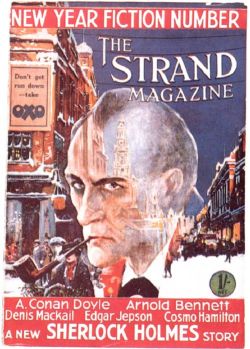 |
| The Strand Magazine, where most Sherlock Holmes stories were published. |
Doyle wrote 24 stories before tiring of his creation. Wanting to turn to more serious writings, he killed Holmes in ‘The Final Problem,’ published in the December 1893 issue
The Strand. In the tale, the master detective appears to meet his end battling his arch nemesis, Professor Moriarty, referred to as “the Napolean of crime.”
In 1899, William Gillette, with the endorsement of Doyle, wrote and starred in a play that debuted in New York. Legend has it that when Gillette asked permission from Doyle to marry Holmes off, Doyle’s response was indifferent, "You can marry him, or kill him, or anything you want," giving Gillette carte blanche to do as he pleased with the character.
However, less than two years later, Doyle’s enthusiasm for Holmes returned. While on vacation in Norfolk, the author was taken with the eerie moors, finding it a worthy location for what may be the detective’s most famous novel,
The Hound of the Baskervilles. Crafting a tale full of creepy settings and spooky legends, it was reasoned that this story took place before Holmes untimely demise, and was published in serial format from August 1901-April 1902 in
The Strand.
Nevertheless, the tale opened open a floodgate of enthusiasm among fans of the detective, leading
Colliers magazine, which had published the stories in the United States, to offer Doyle an astronomical sum to create new mysteries for Holmes. Holmes was resurrected for 13 new cases. The first, “The Empty House,” was released in 1903.
Holmes’ final adventure, “The Adventure of Shoscombe Old Place,” saw print in the April 1927 issue of
The Strand. While it had been almost 40 years since Holmes was introduced, the story takes place just prior to the Great War, cementing him and his companion, Dr. Watson, firmly in turn-of-the-century territory
In addition to William Gillette’s stage portrayal of the famous sleuth, other actors would assume the mantle of the famous detective. Among them were Eille Norwood – whose talent for stage makeup made him the perfect choice for those stories in which Holmes went about in disguise – and Arthur Wotner, who was the spitting image of Paget’s drawings.
 |
| Basil Rathbone, as the Great Detective |
In 1939, Basil Rathbone, famous for playing the villain in such films as
The Adventures of Robin Hood and
The Mark of Zorro, assumed the role for a new production of
The Hound of Baskervilles from 20th Century Fox. A sequel,
The Adventures of Sherlock Holmes, followed before the franchise was transferred to Universal.
However, despite what is one of the most popular film portrayals of the character, the detective was updated to contemporary times. Holmes became a defacto super-spy on behalf of His Majesty’s government, ferreting out saboteurs and battling Nazi spy rings. A total of 12 films were released by Universal between 1942-1946, borrowing elements from Doyle’s writings.
During this time, Rathbone and co-star, Nigel Bruce, also starred in a radio show as Holmes and Watson, with most of the episodes based directly on Doyle’s original stories. Sir John Gielgud and Sir Ralph Richardson later took over the roles in the years that followed.
On screen, Rathbone was a hard act to follow, and Sherlock Holmes on film was rather rare in the years to follow. When Hammer Films began making remakes of some of the classic Universal horror films,
The Hound of the Baskervilles (1959) was among them, starring Peter Cushing.
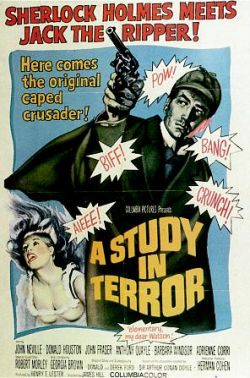 |
| Posters for A Study in Terror capitalized on the wave of Batmani sweeping America |
In 1965, Holmes, as played by John Neville, returned in
A Study In Terror, which pitted the fictional detective against the notorious Jack the Ripper. With Batman all the rage on television, posters proclaimed the Victorian crime fighter as “the original caped crusader,” thanks to the traditional deerstalker costume and cloak.
Other films that followed include
The Private Life of Sherlock Holmes (1970), starring Robert Stevens. Depicting many of Holmes failings, such as his drug habit, it was directed by Billy Wilder, who regarded it as his own personal tribute to the famous slueth. In 1976, Holmes bested his addiction in the movie
The Seven Per Cent Solution. Nicol Williamson starred with Robert Duvall as Watson and Alan Arkin as Dr. Sigmund Freud in a tale directed by Nicholas Meyer, based on his novel. According to the story, Watson fabricated Holmes’ demise at the hands of Moriarty to conceal the detective’s recovery from his cocaine addiction. In 1979, Christopher Plummer starred in
Murder by Decree, as Holmes once again takes on the infamous Ripper murders of 1889.
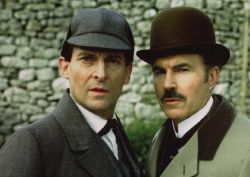 |
| Jeremy Brett and David Burke made a better Holmes and Watson than ever seen before. |
Since then a number of well-known actors have assumed the role, including Charleton Heston, Roger Moore, Thom Baker, Edward Woodward and Matt Frewer. Perhaps the best received of these was Jeremy Brett, who starred in a television series produced in England beginning in 1984. The series ran for 10 years, and has been hailed as the most faithful adaptation of Doyle’s work.
In comics, Holmes has had fleeting success. There were a handful of adaptations during the 1940s, at the height of Rathbone’s popular series of movies, as well as a smattering throughout the 1950s and ‘60s. In 1975, DC published a single issue, adapting “The Final Problem” and “The Empty House” as a complete story. In the 1980s, Batman and other DC sleuths such as Elongated Man and Slam Bradley would find themselves joining forces with an aged and remarkable spry Holmes for a special anniversary issue of
Detective Comics.
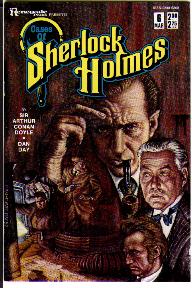 |
| The Cases of Sherlock Holmes, from Renegade Press. Note the resemblance to Rathbone |
In the 1980s, Renegade Press published a handful of issues adapting the original stories. However, the art in these books can best be described as uneven. Rather than the traditional comic book format, the stories are presented as prose, designed around pen and ink illustrations obviously taken from movie stills and photographs. As a result, Holmes lacks a consistent appearance, instead resembling whatever actor’s image suited the illustrator’s need.
Another handful of stories, combining the Holmes legend with other Victorian-era stories such as The Invisible Man and War of the Worlds, were published by Eternity Comics in the late ‘80s, and again in a collected format by Malibu.
Today, Holmes continues to charm new generations of readers, and inspire new entries in the genre of detective fiction. Those would include
Monk, the television adventures of a neurotic but insightful detective, aided by his nurse, and
House, M.D., another show about a pompous but perceptive physician whose lifestyle is similar to that of Sherlock Holmes.
Praise and adulation? Scorn and ridicule? E-mail me at philip@comicbookbin.com
Last Updated: March 3, 2025 - 20:40

